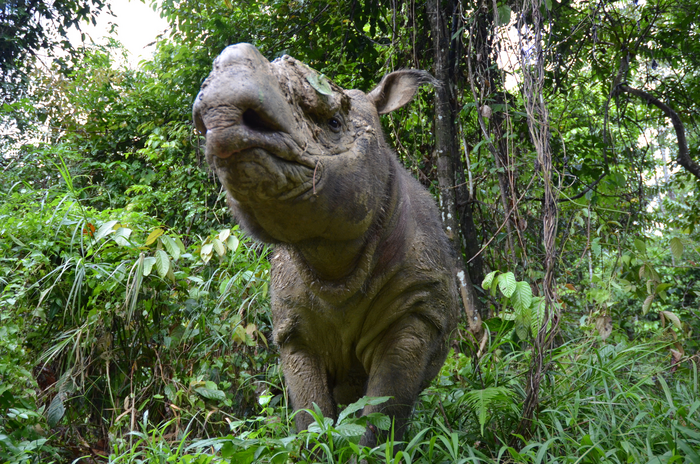
The Sumatran rhino may have another chance at survival
Sumatran rhinos (Dicerorhinus sumatrensis), also known as hairy or Asian two-horned rhinos, are among the most critically endangered large mammal species on Earth. They used to inhabit a continuous, vast area in East and Southeast Asia but the estimated remaining 50-80 individuals are now confined to around 10 fragmented populations that are scattered across Sumatra and Indonesian Borneo. Habitat loss, poaching and limited breeding opportunities continue to cause populations to decline and extinction is now a very real possibility for this, the smallest and most ancient of the five extant rhinoceros species.
Due to the fragmented nature of the remaining population, breeding encounters between males and females are rare, and inbreeding is inevitable. This situation calls for an urgent reintroduction of new genetic material to stop the erosion of genetic diversity. Captive breeding programs involving the nine individuals in zoos around the world have been spectacularly unsuccessful and Kertam, the last male Sumatran rhino in Malaysia, died in 2018, limiting the chances of introducing new genetic material even further.
However, a team of Berlin scientists led by Dr. Vera Zywitza and Dr Sebastian Diecke, head of the Pluripotent Stem Cells Platform at the Max Delbrück Center in Berlin, feel that all is not lost just yet. They and their international partners have set out to turn skin cells taken from now deceased Sumatran rhinos into stem cells, from which they can then derive egg and sperm cells to be used in in vitro fertilization in the laboratory. The embryos formed in this way, which will be the offspring of Kertam and other already deceased or infertile individuals, will be carried to term by surrogate rhino mothers.
In the scientific journal iScience, the team, led by first author Zywitza and last author Diecke, have reported their initial success in this ambitious project – they have produced induced pluripotent stem cells (iPSCs) from the skin cells of Kertam, which were taken by biopsy from this male before he died, and were kept frozen. These iPSCs are a powerful tool to fight extinction because they can be used to make every cell type in a body, including egg and sperm cells. Fertile and viable offspring have already been generated in the laboratory using iPSCs from mice, and the technique is increasingly being applied to a variety of other mammalian species.
Another advantage of producing iPSCs from rare and threatened species is that these cells never die, but continue to divide infinitely. This means they can preserve a copy of the genome from a threatened species for decades into the future, allowing scientists to use the genetic material potentially to resurrect the species. In fact, the technology platform developed its stem cell technologies as part of the BioRescue research project for the even more critically endangered northern white rhinoceros (Ceratotherium simum cottoni) – of which only two females now remain, living in a Kenyan wildlife reserve.
“Our current study has benefited a lot from the knowledge gained through this large-scale project, which is funded by the German Federal Ministry of Education and Research,” says Zywitza. Professor Thomas Hildebrandt, head of the Reproduction Management Department at the Leibniz Institute for Zoo and Wildlife Research (IZW) in Berlin, and his research group, were also significantly involved in the project.
Zywitza recounts how all those involved in the current study were surprised and pleased to discover that the methods used to turn the skin cells of northern white rhinos into stem cells also worked well with the cells of Sumatran rhinos. Under the microscope, the stem cells of both rhino species were barely distinguishable from human iPS cells. Nevertheless, there were species-specific differences: “In contrast to northern white rhino iPSCs, Kertam’s iPSCs could not be cultivated without feeder cells, which release growth factors that help to keep stem cells in a pluripotent state,” explains Zywitza.
The researchers see their success so far as the first step towards fighting the extinction of the Sumatran rhino using stem cell-associated techniques. Their next goal is to use Kertam’s iPS cells to grow sperm suitable for artificial insemination. “This step is more difficult,” says Zywitza. “To obtain sperm cells, we first need to use the iPS cells to cultivate primordial germ cells – the precursors of eggs and sperm.” They also plan to obtain iPS cells from other Sumatran rhinos to increase the genetic diversity in storage, since the reintroduction of genetic material in future will be crucial to support a healthy and self-sustaining Sumatran rhino population.
Reproduction expert Thomas Hildebrandt explains why efforts like these are necessary: “Measures are indeed being taken in Indonesia to preserve the Sumatran rhino population by bringing together the remaining individuals in wildlife reserves,” he says. “But females that have not been pregnant for a long time often become infertile, for example due to cysts that develop on their reproductive organs, or they may just be too old to bear young.”
“Even though our work is attempting to make the seemingly impossible possible – to ensure the survival of animals that would otherwise probably disappear from our planet – it must remain an exception and not become the rule,” emphasizes Zywitza. “Despite all the buzz around what we are doing in the lab, this can at best make a small contribution to saving these rhinos from extinction. The protection and conservation of the animals’ few remaining habitats is at least equally important.”
Image Credit: Ben Jastram, Leibniz-IZW
—
By Alison Bosman, Earth.com Staff Writer
Check us out on EarthSnap, a free app brought to you by Eric Ralls and Earth.com.












